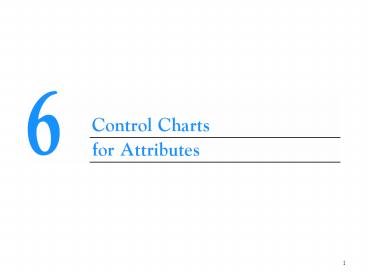Introduction to Statistical Quality Control, 5th edition - PowerPoint PPT Presentation
1 / 79
Title:
Introduction to Statistical Quality Control, 5th edition
Description:
... that there has been a significant decrease in the process fallout ... Method 3:If the in control value of the fraction nonconforming is small, another ... – PowerPoint PPT presentation
Number of Views:336
Avg rating:3.0/5.0
Title: Introduction to Statistical Quality Control, 5th edition
1
(No Transcript)
2
(No Transcript)
3
(No Transcript)
4
(No Transcript)
5
(No Transcript)
6
(No Transcript)
7
(No Transcript)
8
(No Transcript)
9
(No Transcript)
10
(No Transcript)
11
(No Transcript)
12
(No Transcript)
13
(No Transcript)
14
(No Transcript)
15
(No Transcript)
16
- We may formally test the hypothesis
- H0 p1 p2
- H1 p1 p2 where
- p1
- P2 maybe estimated by
-
Z07.10 comparing this to the upper 0.05 point of
Z, Z07.10 Z0.051.645. Consequently we reject
H0 and conclude that there has been a significant
decrease in the process fallout
17
From inspection of Fig 6.4 we see that all the
points would fall insided the revised UCL.
Therefore, we conclude that the process is in
control
18
The continued operation of this control chart for
the next five shifts is shown in Fig 6.5 and data
is shown in Table 6.3
19
(No Transcript)
20
Design of Fraction Nonconforming Chart
- Three parameters must be specified
- The sample size
- The frequency of sampling
- The width of the control limits
- Common to base chart on 100 inspection of all
process output over time - Rational subgroups may also play role in
determining sampling frequency
21
Design of Fraction Nonconforming Chart contd
- Method 1 If p is very small, we can choose the
sample size n so that the probability of finding
at least one nonconforming unit per sample is at
least ?. - For example, suppose that p0.01 and we want the
probability of at least one nonconforming unit in
the sample to be at least 0.95. - PD1 0.95
- using the poisson approximation to the binomial,
we find from the cumulative poisson table that
?np must exceed 3. np3 n ?/p3/0.01300 - From table ?3 is corresponding to the Px0
which is, Then P(x 1)1-P(x0) 1- 0.050.95
22
Design of Fraction Nonconforming Chart contd
- Method 2 Duncan has suggested that the sample
size should be large enough that we have
approximately a 50 chance of detecting a process
shift of some specified amount. - For example, suppose that p0.01, and we want
the probability of detecting a shift to p0.05 to
be 0.5. Assuming that the normal approximation to
the binomial applies, we should choose n so that
the upper control limit exactly coincides with
the fraction nonconforming in the out of control
state. If d is the magnitude of the process
shift, then n must satisfy
Therefore, n(L/d)2 p(1-p) In our example, p0.01
, d0.05-0.010.04
n(3/0.04)2 (0.01)(0.99)56
23
Design of Fraction Nonconforming Chart contd
- Method 3If the in control value of the fraction
nonconforming is small, another useful criterion
is to choose n large enough so that the control
chart will have a positive control limit. This
ensures that we will have a mechan to force us
to investigate one or more samples that contain
an unusual small number of nonconforming items.
Since we wish to have
This implies
For example, if p0.05
Thus, if n 172 units, the control chart will
have a positive lower control limit
24
(No Transcript)
25
(No Transcript)
26
(No Transcript)
27
(No Transcript)
28
(No Transcript)
29
(No Transcript)
30
(No Transcript)
31
Variable Sample Size contd
32
(No Transcript)
33
(No Transcript)
34
(No Transcript)
35
(No Transcript)
36
The probability of type II error for the
nonconforming control chart may be computed from
It displays the probability of incorrectly
accepting the hypothesis of statistical control
(ß error) against the process fraction
nonconforming
37
Where nUCL represents the largest integer to
the nUCL, and nLCL represents the smallest
integer to the nLCL
38
(No Transcript)
39
(No Transcript)
40
(No Transcript)
41
(No Transcript)
42
(No Transcript)
43
(No Transcript)
44
(No Transcript)
45
(No Transcript)
46
(No Transcript)
47
(No Transcript)
48
(No Transcript)
49
(No Transcript)
50
(No Transcript)
51
X Total nonconformities n inspection unit
observed number of nonconformities per unit
52
(No Transcript)
53
(No Transcript)
54
(No Transcript)
55
(No Transcript)
56
(No Transcript)
57
(No Transcript)
58
(No Transcript)
59
With complex products such as automobiles
computers, or major appliances, we usually find
that many different types of nonconformities can
occur. Not all of these types of defects are
equally important. One possible demerit scheme is
defined as follows.
60
(No Transcript)
61
(No Transcript)
62
Recall that
63
(No Transcript)
64
For the u-chart, we may generate the OC curve
from ß XC Where nLCL denotes the smallest int
eger greater than or equal to nLCL, andnUCL
devotes the larghest integer less than or equal
to nUCL
65
- When defect levels or in general, count rates, in
a process become very lowsay, under 1000
occurrences per millionthere will be very long
periods of time between the occurrence of a
nonconforming unit. Conventional c and u charts
become ineffective as count rates are driven into
the low parts per million (ppm) range. - The time-between-events control chart has been
very effective as a process-control procedure for
processes with low defect levels. If the
events of interest occur according to a Poisson
distribution, the probability distribution of the
time between events is the exponential
distribution. - Constructing a time-between-events control chart
is essentially equivalent to control charting an
exponentially distributed variable.
66
(No Transcript)
67
(No Transcript)
68
(No Transcript)
69
(No Transcript)
70
(No Transcript)
71
(No Transcript)
72
(No Transcript)
73
(No Transcript)
74
(No Transcript)
75
(No Transcript)
76
(No Transcript)
77
(No Transcript)
78
(No Transcript)
79
(No Transcript)































